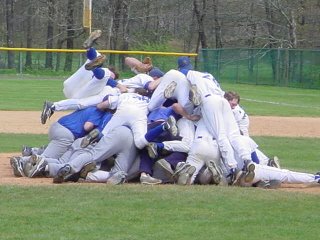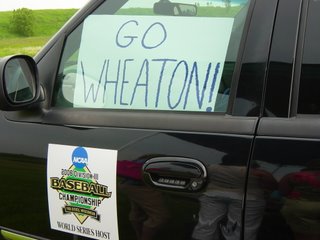In America (and countries like the Dominican Republic, Mexico, Cuba and other baseball-playing nations), little boys learn the game from their fathers. Most begin acquiring the knowledge and a working understanding of it at an early age.
My son, Mark, was introduced to baseball around the age of three, via a plastic
Wiffle ball bat. With the care common with dads passing on their love of something, we spent many an evening in the backyard of our rented duplex in Indiana (we'd be moving back to the Pine Tree State the next year), bonding around a plastic bat and ball.
It might be naïve on my part, but I swear that Mark exhibited precocity towards hitting a ball. Even at three, he’d swing so hard that he’d fall down, trying to hit the ball. He probably only made contact three out of ten times I pitched the ball his way, but when he did hit it, it would sail over my head and I’d think, “maybe I’ve got a ballplayer for a son.”
As soon as he was eight (the earliest Mark could enter any organized aspect of baseball), my wife and I signed him up for t-ball. While this is usually a good first introduction to baseball, with youngster hitting the ball off a stationary, rubber tube, affixed to home plate, for Mark, it was not “real” baseball because they didn’t keep score. He has always been a competitor and the excessive nods to “fairness” of t-ball drained this youthful version of baseball of any meaning for Mark.
His four years playing Little League were very enjoyable and he began to show his considerable talent. I coached and our teams began to dominate the league. I spent many hours teaching the game and the proper way to play it, to Mark, as well as the other 14 or 15 young men (and occasionally, young ladies) on the team. By his 12-year-old year, we had an undefeated team and I began to receive some of the ire commonly directed at coaches by overbearing parents of Little Leaguers. Most often this would be coming from people that knew next to nothing about sports and the proper way to coach them.
While I had a one year stint coaching my son in middle school, I no longer coached Mark as he began to mature and exhibit an ability to launch baseballs up and out towards outfield fences. We still spent many hours on deserted ball fields, emptying buckets of baseballs, with me throwing batting practice until my arm was jelly, or hitting countless fungoed ground balls to a budding young first baseman.
It is in high school when fathers of talented youngsters begin to receive some validation for their efforts. After successful junior and senior years of high school, as well as his final summer American Legion campaign where it seemed like he hit a homer most nights, my son had grown to a lanky 6’3” and was off to play baseball at
Wheaton College, a Division III baseball program on the move. The year before Mark arrived, the Lyons had their first player taken in the Major League baseball draft.
Chris Denorfia, an immensely talented outfielder was drafted in the 19th round by the Cincinnati Reds. In three years, Denorfia would make his major league debut in September and hit his first home run. His time at Wheaton saw the Lyons become one of the top Division III programs in New England, often attracting players who were talented and should have been given a shot at much larger, Division I schools. Instead, these blue chip players opted for the more rigorous academic opportunities, the smaller school size and still had an opportunity to have a rigorous college baseball experience.
My wife and I got used to three hour drives each weekend to watch our son mostly ride the pine during his freshman year. While it’s hard to watch your son not play, especially when you’ve had high hopes for him since three and spend hours teaching him the finer points of the game, my wife Mary also struggled with Mark’s lack of playing time.
It’s a good thing for parents to learn to let go of their children and allow them the space they need to mature. Mark continued to work hard and his sophomore year yielded his first significant playing time.
By his junior year, Mark had become a hulking 6’3” and 225 pounds of lean muscle. He put up phenomenal numbers over the 2005 campaign and was selected to the all-New England team, as their first-team designated hitter. He had the third best offensive season in school history. With a strong showing in the 2005 Northeast Regional, where they bowed out to a strong Trinity club in the regional finals, the team seemed poised for bigger and better things in 2006.
While baseball is a game that focuses on individual statistics and more than any other major sport, it truly is a game driven by numbers, it is first and foremost, a team game. Regardless of how well individuals do, the performance of the club, as far as winning or losing goes, is dependent on the efforts of nine or more players. A player can hit home runs, or pitch brilliantly and still come out on the losing end if everyone isn’t hitting on all cylinders.
The 2006 Wheaton season was a wonderful illustration of this to me and I don’t think it was lost on Mark. While the team didn’t get off to the kind of start that would indicate a season of historic proportions, there were obviously signs of tremendous talent. On the annual southern trip to Florida, to play 10 days of baseball in conditions more conducive to pitching and batting a ball, the team came back north with a mark of six wins and three losses, after having played some of the top Division III teams in the country. The pitching appeared especially strong and abundantly deep, but the bats showed inconsistency and the infield defense was porous. Mark, after hitting well in the first two games began to scuffle at the plate. In a pattern that would befuddle him much of the season, with games that seemed to indicate he had found the stroke that made him one of the most-feared players in the blue-and-white lineup in 2005, he inevitably would find himself back in the funk of a slump. As a father, I had stopped offering unsolicited advice to my son. While I had the privilege of coaching him for the past three summers, as well as other talented college players, I knew better than to be the overbearing dad of my earlier years.
After suffering a loss to Bridewater State College, the Lyons proceeded to win one and lose two during the first week back playing on the barren and brown fields of northern New England.
On Tuesday, March 28, Wheaton bussed over to Waltham for an afternoon game at Brandies. Once again, the Lyons were having trouble catching the ball. Finding themselves down by a 4-2 count, going into the ninth, the club rallied for three in their half of the ninth to go up, 5-4. With their closer, Jamie Baker shutting down the Judges’ bats, Wheaton ended up with a win and the beginning of an unbelievable streak of wins.
Over the next five weeks, the Lyons would not lose. On April 12th, they erased a 6-0 deficit on route to a 13-7 thrashing of Bridgwater State, tying the school record for consecutive wins, with their 11th consecutive victory. The following day, once again, the Lyons came from behind to against Worcester State, with a hard fought 8-7 win and set a new Wheaton record for wins in a row.
The Blue and White ended up winning 24 consecutive games during this unbelievable run of baseball. During this period, they would come from behind 16 times. Pitching and defense wins baseball games. For the Lyons, their staff became one of the best in the nation and the defense was solidified. The bats hit just enough day after day and the Lyons blew through their conference tournament on route to a top seed in their regional tournament.
While the Lyons had been to the regionals three out of the four years Mark has played, never before had they gone into this five day tournament with such high hopes and expectations. When you’ve been ranked as high as fourth, nationally, as well as being the top ranked team in New England all season, the expectations were high.
Wheaton didn’t disappoint, as they systematically eliminated their opponents. With this year’s field expanded to seven, the top seed was more important than previous years. By winning the opening night, Wheaton could put themselves in the driver’s seat.
Their 5-2 win over a strong Salem State team Wednesday night put them in a place they wanted to be. This gave them a day off and forced the remaining teams to chew up their pitching. On Friday, the Lyons dispensed with Western New England, a club that had beaten them on the final day of the regular season. Senior Chris Martin won his seventh game and shut down the potent bats of the Golden Bears.
Saturday would find Wheaton matched against the University of Southern Maine, a program with two national titles, the last one coming in 1997. Coached by the volatile Ed Flaherty, the Huskies were a club that received a surprising at-large invite. While not expected to do much, the young club surprised the rest of the field and found themselves with an opportunity to knock off the top club and make yet another appearance in the Division III World Series, in Appleton, Wisconsin.
When the Huskies jumped out to a 2-0 lead in their top of the first, it appeared that they had their sights on an upset. Wheaton however, never flustered by a deficit, put up a four spot in their bottom half. Mark, who showed signs of breaking out of a season-long slump, singled in a run during the early outburst.
The Huskies came right back in the top half of the second and loaded the bases with a walk and two hit batsmen. This brought Wheaton’s coach, Eric Podbelski out and sophomore Josh Moore into the game. The lefty managed to strike out the first two hitters he faced and induced a harmless grounder and the Lyons had dodged an early upset bullet. Before all the dust had settled, the club would end up pummeling the Huskies’ over-worked pitching staff for 17 hits and 16 runs—Mark added a double to the barrage, in addition to his first hit. For the first time in program history, the baseball team was advancing to the World Series.



This is an exciting time for the Baumers and many other Wheaton baseball parents. When Coach P was recruiting our son, he told my wife and I that Mark had an opportunity to play for a team that could possibly play for a national title. While it seemed hard to fathom at the time, four years later, we’ve booked our flights and are making our last-minute arrangements to journey westward, to Appleton, Wisconsin.
While this season has been a record-setting one for the team, for Mark, it’s been a struggle. Yet, he rarely, if ever, showed his disappointment, basking in the glow of victory and team and not the limelight of individual success. While we haven’t talked about it, I’m sure there are times that this season has been difficult. Having struggled with my own issues around baseball success at a similar age, I empathize with what he goes through and as a dad, wish there was some way I could save him from the hard lessons that sports and life can teach us. However, knowing that there is always light at the end of the tunnel and that baseball, while fun to play, is merely a game, helps to put it in the proper perspective.
I don’t know where this season will take us and if Wheaton has enough to overcome the other seven teams from their respective regions of the country. Regardless of the outcomes of the game, this has been a fitting finale to Mark’s four years at Wheaton. Not only has he played for a topnotch team and a classy coach, but he also has excelled academically and is well-prepared to go out into the world and hopefully, make his mark. And on top of all of this, we are still playing and my wife and I will get to visit a new area of the country.
Labels: Sports writing; The Baumer family





